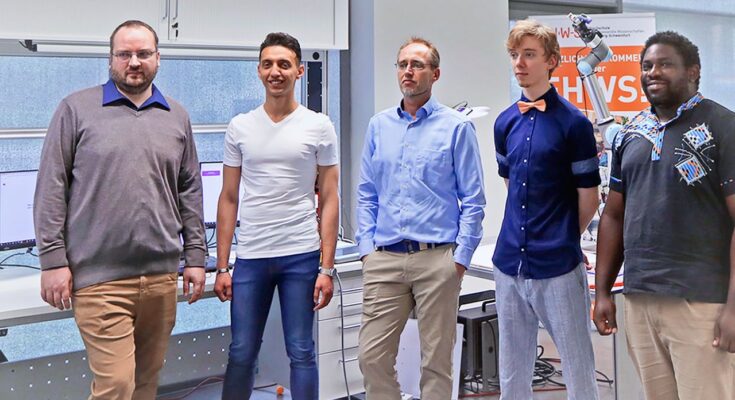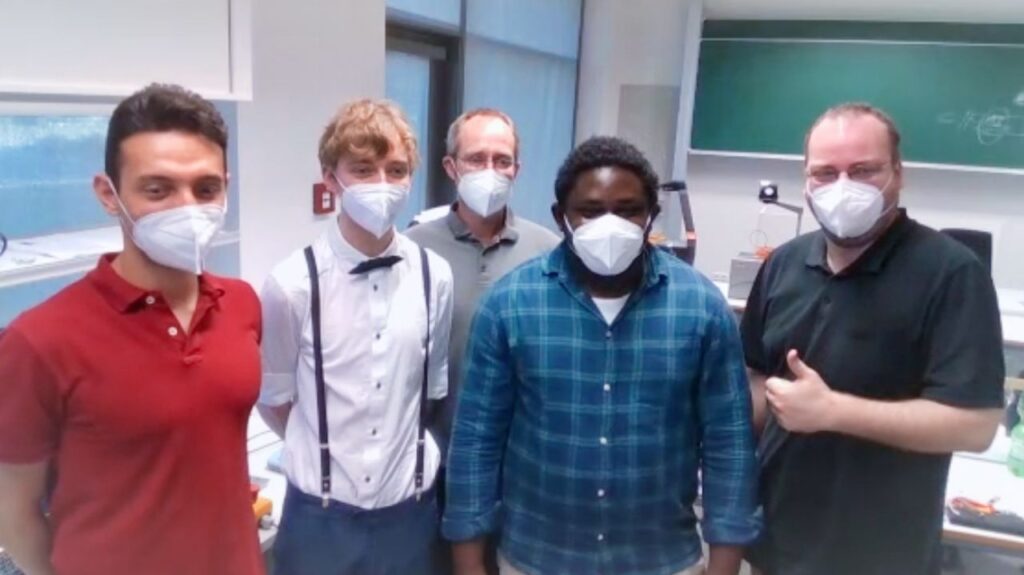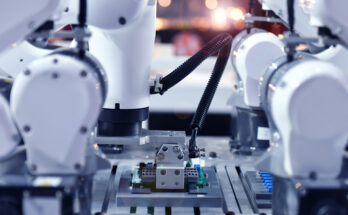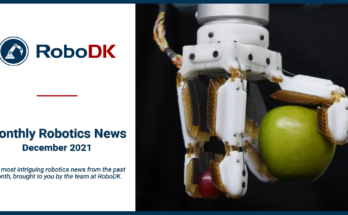What’s the most efficient way to program a robot in a competition?
One team of students from the University of Applied Sciences Würzburg-Schweinfurt used RoboDK. They earned the winning spot in the first Robothon Grand Challenge 2021.
In an international robotics competition, you need to program your robot quickly and efficiently.
There’s no time for you to mess around with complex code files or arcane manufacturer-specific programming languages. Spending as much of your valuable time developing the functionality of the robot will earn you points in the competition.
In the first-ever Robothon Grand Challenge, the winning team of students made sure they spent all their time on the core functionality of their robot by using RoboDK for programming.
Here’s how they did it!
The Robothon Grand Challenge 2021
The Robothon Grand Challenge was held during Automatica Sprint 2021, an offshoot of Automatica, the world’s leading robotics trade fair.
Due to the Covid-19 pandemic, the event was held virtually in June to provide a digital platform for the robotics industry to get together and provide support to the community.
The Robothon Grand Challenge is an international competition in robot manipulation. The aim is to use robotics to address pressing issues facing the economy and the environment.
This year, the specific aim of the competition was to find intelligent solutions to increase the recycling rate for e-waste.
The Challenge: Disassembly of E-Waste
The competition entrants needed to complete an integration task. In fact, they had to create a robot that could disassemble an electronic product for recycling.
As the competition organizers explain:
“Electronic waste continues to accumulate and, consequently, so does the amount of precious and toxic materials entering landfills; unless properly disassembled and sorted. This work is repetitive, dirty, and dangerous which makes it a great use case for automation and robotics.
“With our challenge, we want to offer young talents and academics the chance to actively participate and shape the future of robotics in science & industry.”
The winning team explains that, currently, only 20% of the worldwide e-waste is recycled. With this in mind, projections show that by 2050, the amount of e-waste will increase to 120 million tonnes. Furthermore, e-waste is not just an environmental problem but also has a huge financial value estimated at $62.5 billion.
However, there is currently no completely automated solution to recycling e-waste on the market.
Due to the unstructured nature of e-waste, it requires advanced sensors and algorithms to detect, recognize and localize e-waste components. Moreover, it also needs fine-grained manipulation to separate different types of e-waste components.
How Robots Can Reduce E-Waste
The concept behind this year’s challenge is that robots can be a good solution to dismantle e-waste and sort it for further processing.
In brief, the challenge included 5 levels, which each team had to complete using the official competition task board:
- Button press — The teams first had to program their robot to press a button on the task board. The more times the robot pressed the button in the allotted time, the more points they earned. This means the task prioritized efficient movement.
- Peg in hole port insertion — A classic manipulation task. Peg in hole is a demonstration of the robot’s ability to insert parts during assembly. In this case, it involved removing and reinserting a plug into a socket.
- Key in keyhole — The robot then had to pick up a key, insert it into a keyhole, and turn it.
- Battery removal — The teams had to program the robot to remove the cover of a battery case. They had then to extract the batteries inside. This is quite a complex task for a robot as it involves several fine motor skills.
- Battery recycling — Finally, the robot had to pick up the battery and insert it into a hole. This triggered a button press. Again, more button presses earned more points.
Introducing… the RoboPig Team
The winning team came from the University of Applied Sciences Würzburg-Schweinfurt.
The team was made up of Elhasan Mohamed and Desmond Fomelack (who study mechatronics), Felix Pagels (technical mathematics), and Martin Löser (lab employee and graduate engineer). The team was established and supervised by Dr. Tobias Kaupp, a professor of robotics and digital production.
Team captain Elhasan Mohamed explained what it was like using RoboDK for this project:
“As a robotics student, I enjoyed working and developing with RoboDK. It allows me to use its built-in tools, and at the same time, to build something on the ground level that fits what I need exactly.
“I would definitely recommend it to someone who just started learning robotics but also to a robotics engineer that deals with industrial robots in a professional way”
The Team’s Robotic Setup
The team’s robot setup incorporated a few different hardware and software elements to complete the task.
The core components of their solution were:
- A Universal Robots UR5e collaborative robot with integrated force sensor
- A Robotiq Hand-E precision gripper
- An Intel RealSense depth camera
- 3D printed custom jaws to handle the parts
- OpenCV computer vision library
- Python programming language
- RoboDK
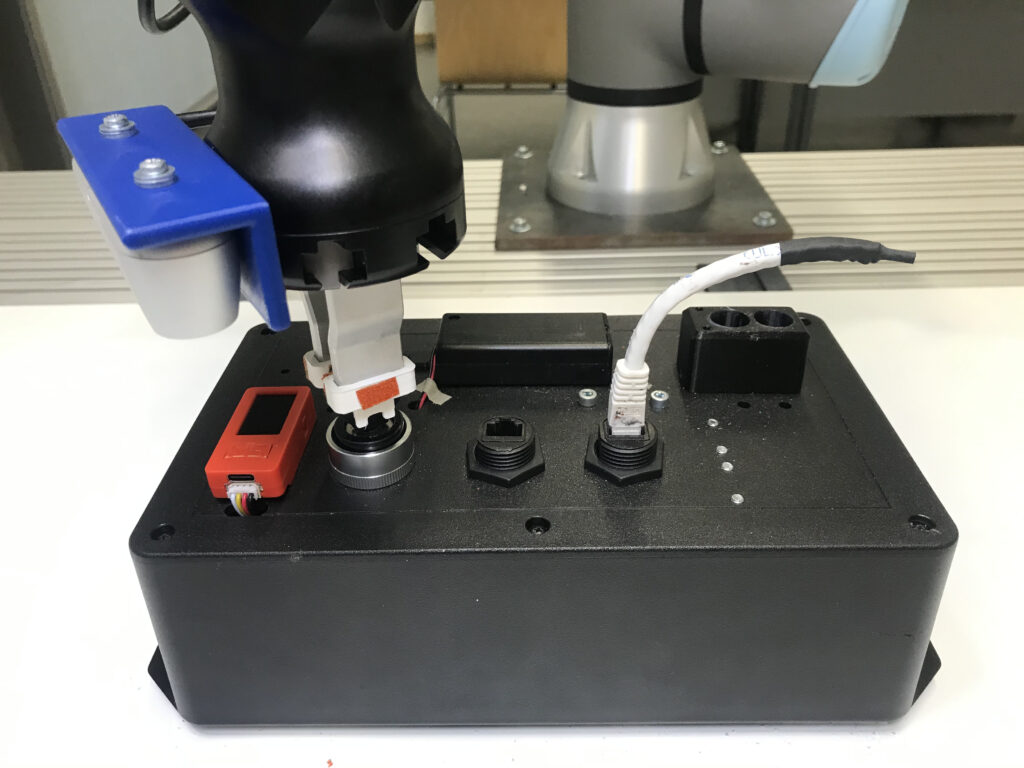
By using these off-the-shelf components, the team got their robot up and running quickly and efficiently without “reinventing the wheel”.
Indeed, this efficient hardware integration allowed them to have more time and energy on creating a robot program.
Why the Team Used RoboDK
The team’s programming setup revolved around our RoboDK offline programming software.
They had 4 main reasons for choosing RoboDK over the alternatives were:
- It allowed them to quickly acquire skills in basic robotic manipulator programming.
- The RoboDK API enabled the integration of robotics and machine vision, which they needed for their solution.
- The RoboDK toolset is easy to use and they avoided investing time in using multiple other solutions.
- RoboDK’s visualization features allowed them to develop the solution rapidly and effectively.
Overall, the choice of using RoboDK made sure that their integration tasks would be as efficient as possible. Instead of fiddling around with too much complex low-level robotics code, the tool allowed them to focus all their core development effort on integrating the more advanced parts of their program.
This is perhaps a contributing factor to the RoboPig team being one of only 4 of the 10 competition entrants to complete all of the competition task levels.
Their Robotic Program
The team’s robot program completed the task with the following steps:
- The vision sensor used 2D image processing to roughly localize the task board in the workspace.
- The robot’s force feedback was used to perform fine localization of the board.
- With the position of the board now known, the robot pressed the button for the Level 1 task then picked up the key from the board.
- Using force feedback the robot inserted the key into the hole for the Level 2 task.
- Force feedback was also used to extract the connector in Level 3 and insert it into a new socket.
- The robot then removed the cover of the battery pack for Level 4 and ran through a sequence of preprogrammed motions to extract the batteries.
- The robot then used a Spiral Search method to insert the battery into the final part of the task board for Level 5.
RoboDK’s simulation provided them a fast, agile development and debugging environment for these steps. Both for robot movement and image processing. Moreover, it also allowed them to easily set up a fixed coordinate system for the task board. Finally, they succeeded in setting up a real-time visualization of the robot as the program was running.
This video shows the winning robot deployment in action:
How could RoboDK speed up your robot deployment? Tell us in the comments below or join the discussion on LinkedIn, Twitter, Facebook, Instagram, or in the RoboDK Forum.

